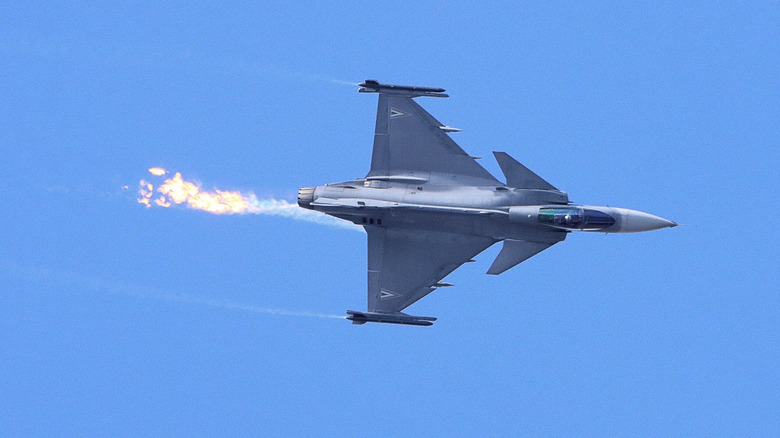 Airwolfhound/Wikimedia Commons
Airwolfhound/Wikimedia Commons
If you saw the name Saab and a tickle developed somewhere deep in the back of your mind because you know that name from somewhere, you're not wrong. Once upon a time in the United States, automobiles from Swedish carmaker Saab once rolled through the countryside. From time to time, you can still see one out in the wild, but they're pretty rare.
Those cars came from Saab Automobile, a subsidiary of Saab AB, which had been building them since the late 1940s. In 2000, General Motors acquired them; eleven years later, the division went bankrupt, and the Saab brand ceased to exist. However, Saab AB is still alive and kicking, and is the defense contractor that manufactures the JAS 39 Gripen. In fact, that part of the company has been making planes for the Swedish Air Force since 1937.
The Gripen happens to be one of Europe's best frontline multirole jet fighters. Knowing that it's made in Sweden will help in understanding the meaning of the JAS acronym — Jakt, Attack och Spaning, which (in Swedish) means "Hunting, Attack and Reconnaissance," describing some of the Gripen's incredible features. To be more precise, "Jakt" refers to its air-to-air capabilities. "Attack" defines its air-to-ground proficiency, and "Spaning" (sometimes seen as Spaningsplan) addresses its knack for carrying out reconnaissance. The Gripen took to the skies on its maiden flight in 1988 and became an official part of the Swedish Air Force in 1997.
The Gripen can hunt with the best of them (at less cost)
 Julian Herzog/Wikimedia Commons
Julian Herzog/Wikimedia Commons
As for the fighter's primary name, Gripen, that's Swedish for the Griffin, which, if you know your mythology, is a mighty beast with the head, wings, and front talons of an eagle combined with the body of a lion. Pretty ferocious creatures, as the legends of old would have it, so it's an altogether fitting name for a warplane that zips around hunting, reconnoitering, and attacking would-be enemies. Ironically, the name came about through a contest posted in the Swedish Air Force magazine ("FlygvapenNytt"). It was won by flight attendant Helena Sillen, who suggested that since the mythological beast was seen as the king of both heaven and earth, no one would dare get in its way.
The latest version of the Gripen E is equipped with state-of-the-art tech, including artificial intelligence-assisted systems that provide pilots with enhanced situational awareness, all displayed on a wide-area cockpit display. The electronic warfare (EW) suite called Arexis can detect, jam, and defend against incoming enemy threats using electronic attack jammer pods and air-launched decoy missiles. The Gripen's EW system can even detect targets 10 times smaller than usual and provide 360-degree protection. Meanwhile, GE's F414G engine (just one of several fighters that use GE engines) gives it 20% more thrust.
Despite all the latest bells and whistles, it still maintains a relatively low operational cost, at least when compared to the Lockheed Martin F-35 Lightning II, which is three times that of the JAS 39. Ultimately, this makes it one of the most cost-effective fighter jets in the air today.



